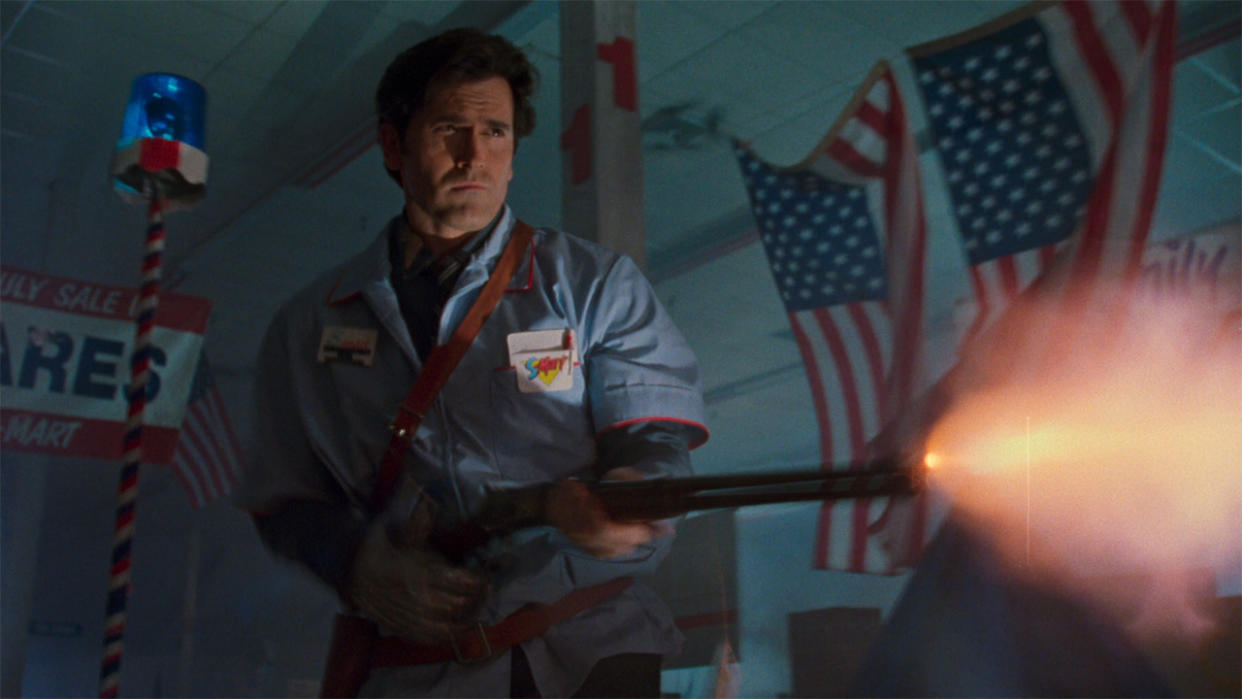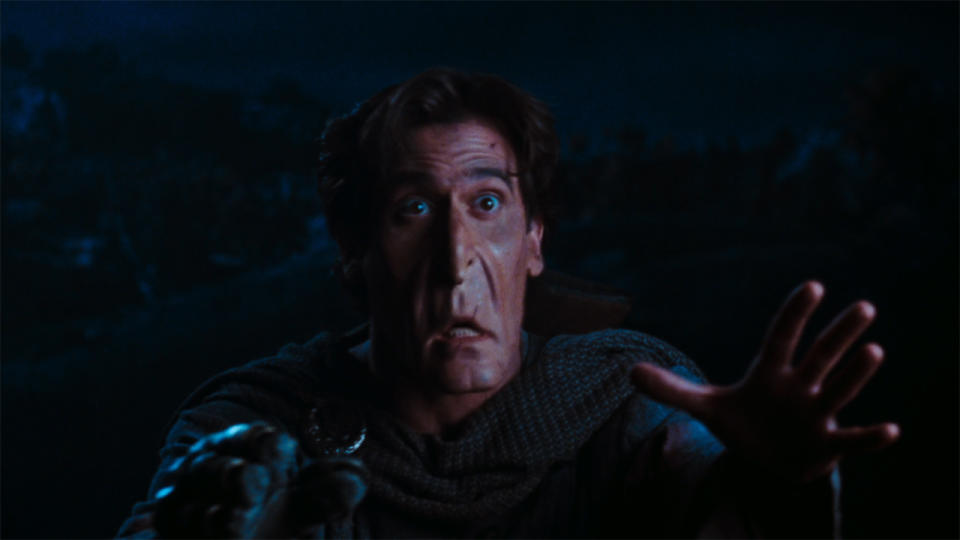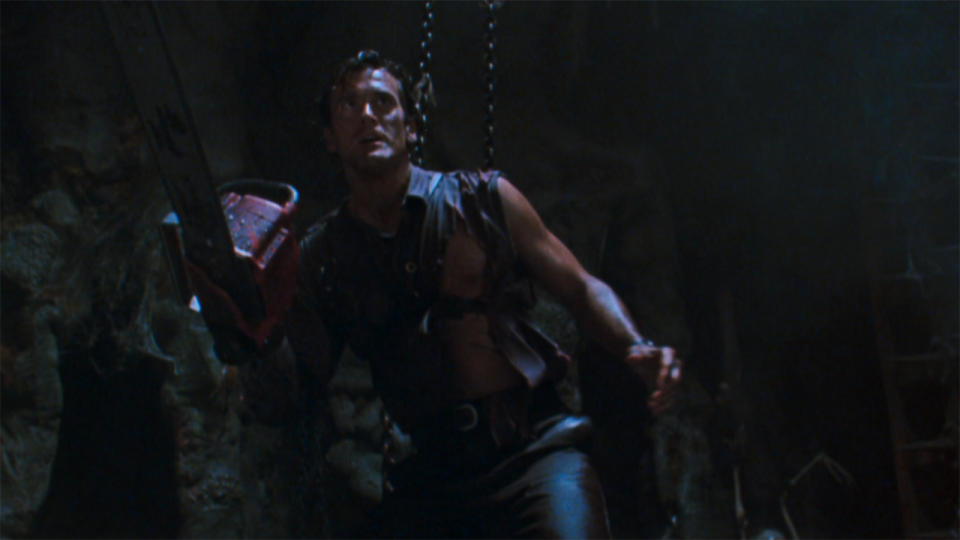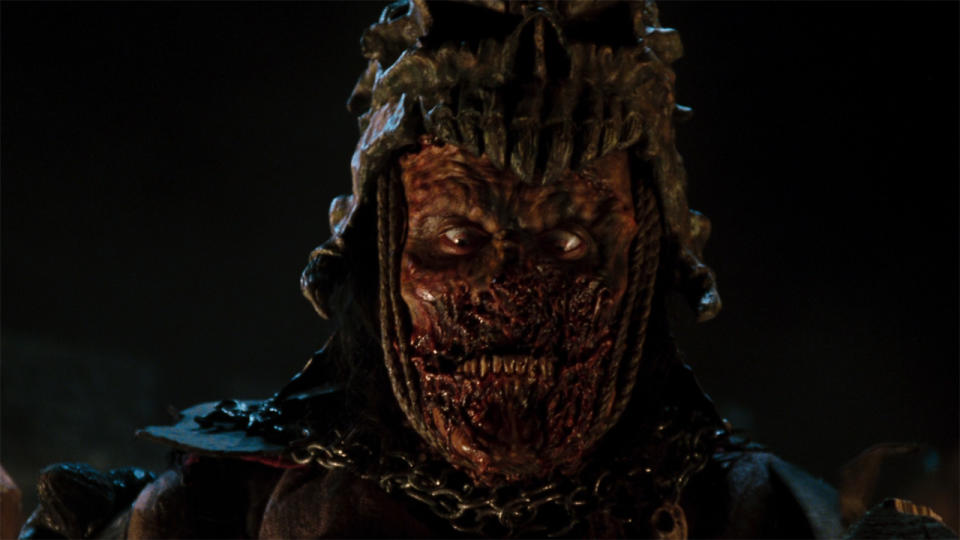Evil Dead's History And Legacy: 1993's Army Of Darkness Pivots To Adventure Comedy And Cements Bruce Campbell's Ash Williams As A Legend

In the vast majority of cases, studios develop sequels because they want to take advantage of the popularity of previously released films, but director Sam Raimi’s Army Of Darkness exists as a strange exception. Unlike Evil Dead II, which Raimi resisted developing until after his second feature was a disastrous flop, Army Of Darkness was a follow-up that the filmmaker wanted to make in collaboration with producer Rob Tapert and star/producer Bruce Campbell, and he even had a franchise-fitting title in mind: The Medieval Dead.
In the early 1990s, Universal Pictures (which had produced Raimi’s 1990 film, Darkman) decided that they wanted to make Raimi, Tapert, and Campbell’s movie… but minus all of the baggage from its two predecessors. Continuity would be maintained within the actual film, but a new title was demanded that would allow it to be marketed as a standalone. According to the home video commentary track, it was The Evil Dead and Evil Dead II producer Irvin Shapiro who came up with Army Of Darkness.
With a script co-written by Raimi and his brother, Ivan, the film went into production in the Los Angeles area, and it was a grueling experience for both the cast and crew. Principal photography lasted for more than 100 days, and not only was time on set filled with complicated effects, makeup application, extra wrangling, battle sequences, and fight choreography, but most of work was done at night. It was a far more organized and structured effort than what was executed in the making of The Evil Dead, but it was a marathon – and one that led into far more post-production complications.
The movie was shot in the summer of 1991, but it first sat on a shelf following completion because Dino De Laurentiis, a key producer on both Evil Dead II and Army Of Darkness, was in the midst of a legal battle with Universal concerning the rights to the character of Hannibal Lecter (the former having produced director Michael Mann’s Manhunter and the latter having made director Jonathan Demme’s Silence Of The Lambs). According to the documentary, Medieval Times: The Making Of Army Of Darkness, that issue was eventually resolved, putting gears back into motion for the second Evil Dead sequel… but then the studio started test screening the movie.
Some of the best sequences were significantly edited by the studio (the theatrical cut is about 15 minutes shorter than the director’s cut), but Universal’s big takeaway from early Army Of Darkness screenings was insistence that the ending that had been shot was too bleak – featuring Ash using a sleeping potion to return to the 20th century, but accidentally taking too much and waking up in an apocalyptic future. In Medieval Times, Bruce Campbell explains that it was meant to be a setup for an Evil Dead 4, but the studio couldn’t be convinced to keep it:
We thought that [ending is] perfect! Because the lead-in to the next movie is Ash leads a team of robots against the Deadites. He’s Omega Man. It would be fantastic. [Evil Dead] 4 would be great – Ash leading an uprising of robots against the Deadites. We thought that was way better, but because the audience thought it was a downer ending because, again now, it’s a studio movie so you’re going to do previews, so at the previews they were like, ‘Oh no, it was sad. Bad ending. Bad ending.’ So they wanted a positive ending.
A new final sequence was shot, with Ash making his way back to the present and successfully neutralizing a Deadite attack at the big box store where he works. And despite being the result of a compromise, it’s remarkably badass.
Lastly, there was the conflict with the Motion Picture Association of America. The Evil Dead franchise had previously been able to skirt around the ratings board, going as far as to invent a fake distributor to put out Evil Dead II, but that wasn’t happening with the Universal-produced Army Of Darkness, and as Campbell explains in Medieval Times, the MPAA saw the film as an opportunity for revenge:
We finally came to them to get the rating for Army of Darkness, and the ratings board was like, ‘We’re going to get you guys!’ The fact that the movie did not get an R-rating when we first submitted it cracks me up. They wanted to give it an NC-17 – to Army of Darkness, with talking skeletons. The ratings board has its head so far up its ass it’s ridiculous. We asked them, ‘Well, ok, what should we cut?’ They go, ‘Well, it’s the cumulative effect.’ ‘You have [to tell] us what to cut!’… I don’t know what we cut out. I think we just resubmitted it, went, ‘There, we cut stuff out.’
Finally hitting theaters in February 1993 sporting an R-rating, Army Of Darkness was far from a hit – making $11.5 million globally while sporting a $13 million reported budget – but it is a film that time is exceptionally kind to, and it’s a key part of Evil Dead’s History and Legacy.

Why Army Of Darkness Is The Third Best Movie In The Evil Dead Franchise
If I was a hardcore Evil Dead fan going to see Army Of Darkness when it first came out, I’m not totally sure I would have known what to make of it. It certainly continues the story from the first two installments in the series, but it’s a wholly different cinematic experience – one that limits on-screen blood to a single geyser in the first act and has a third act overflowing with Ray Harryhausen-esque fighting skeletons.
Time, however, lets us see and respect the macro tonal trajectory that Raimi, Campbell, Tapert and their cohorts orchestrated with the movies and express tremendous gratitude for it. It doesn’t quite match the highs of The Evil Dead and Evil Dead II, rendering it the third best feature in the franchise thus far, but it is an amazing, silly ride that features Campbell’s greatest and most memorable turn as Ash Williams.
A huge part of this is the work that’s done by special effects. Greg Nicotero, Robert Kurtzman, and Howard Berger follow up their phenomenal work with Raimi & Co. on Evil Dead II by crafting even more memorable and freaky monsters (the dead eyes and gaping maw of the Pitch Witch being particularly unforgettable), and their designs are matched by what Tony Gardner is able to do with Ash (in both comedic and horrific capacities). Through and through, Army Of Darkness is brimming with remarkable and special filmmaking craft – and as we don’t see many films like it today thanks to advances in digital effects, time has made it only more impressive, and much of it seems like magic.
Raimi acknowledges on the film’s commentary track that he personally disengages with Ash as a protagonist in the third act as he becomes a more traditional big screen hero – but I’d argue that Army Of Darkness more finds a way to have its cake and eat it too with the on-screen talents of Campbell. There are plenty of scenes of the character being a total weenie/dolt who is being endlessly abused by evil forces (Raimi’s favorite mode), but the movie also embraces the natural charm and charisma of the star by letting him exhibit some impressive physical skills and deliver more than a few brilliant one-liners. Hail to the king.

How Army Of Darkness Fits Into The History Of Horror
Of all the installments in the Evil Dead franchise, Army Of Darkness strays away from horror the most… and it’s funny that the pivot is unintentionally timed to a down era for the genre (a time that arguably could have really used a great and scary Evil Dead movie).
As I wrote about in my feature centering on Wes Craven’s Scream (the first installment of this Horror History and Legacy column), the early 1990s is not reflected upon as being a memorable time for cinematic scares. Thanks in large part to the slasher genre, the 1980s was in many ways a golden era, but by the early years of the next decade there was a lot of burnout that came as a result of repetitive stories and too many sequels. There was a pervasive lack of quality (with some key exceptions, of course), and helping nothing was dwindling audience interest and ticket sales.
While more fantasy/adventure than horror, Army Of Darkness certainly performed like scary movies of the era during its theatrical run – but like a lot of other terrific films of the time that were under appreciated upon their initial release, the movie eventually found a cult following thanks to home video and the ever-growing Evil Dead fandom, which, decades later, led to the franchise’s revival in the 2010s (which I’ll be digging into starting next week).

How Army Of Darkness Changes Its Franchise’s Canon And Future
As will be further discussed in a couple of weeks in my column about the TV series, Ash vs. Evil Dead, Army Of Darkness’ position in the canon is a bit strange. Because the movie was made and distributed by Universal Pictures, the Starz-developed show didn’t have the rights to directly reference it or follow it up, forcing the filmmakers to dance around it. In advance of the third season airing in 2018, Bruce Campbell explained to Den Of Geek,
That was a conscious decision by us to not include certain scenarios, characters, props, events that would have gained us unnecessary partners in the business sense. We have a lot of elements that we own free and clear of other partners, and if you make a TV show you don’t always want to dash in with a lot of partners both creatively and economically…So, if people are saying, ‘Why are you avoiding that?’ We consciously made a decision that with Ash, a chainsaw, a book, a shotgun, time travel, and a Delta ‘88, you’ve pretty much got what you need.
Because of the rights issues, Army Of Darkness specifically doesn’t have a major impact on the continuity that follows it… but, of course, a lack of strict continuity has always been a part of the Evil Dead franchise’s charm. Evil Dead II is a semi-remake of The Evil Dead that changes a lot of key details (a result of the production not legally being able to use footage from its predecessor), and it’s hard not to notice that the end of Evil Dead II, where Ash is hailed as a savior after shooting a Deadite out of the sky, is disregarded at the start of Army Of Darkness.
At the very least one could say that the film reinforces the key qualities of Ash Williams as a protagonist in the franchise, painting him as equal parts heel, ham, and hero.

Is Army Of Darkness A Good Horror Movie In General?
Judging Army Of Darkness as a horror movie is complicated because, as noted, that’s not really where its focus is. If one were to limit it to a single genre designation, it’s definitely more of an adventure story. Anyone watching it expecting the level of scares and gore from The Evil Dead or Evil Dead II is going to be disappointed – but at the same time, there is still plenty to appreciate here by a genre aficionado who appreciates the many flavors of horror.
While not explicitly scary, the Deadite showdowns that Ash has throughout the movie are made plenty freaky by the fantastic creature design done by KNB EFX Group, and I can’t imagine that there is a single cinephile on the planet who can’t have at least a baseline appreciation for the brilliant effect that sees “Bad Ash” grow out of “Good Ash’s” shoulder.

How To Watch Army Of Darkness
Those of you who are aiming to catch up with the Evil Dead movies in advance of Evil Dead Rise hitting theaters should note that Army Of Darkness is not presently available on any of the major subscription streaming services, but there are many options to watch. On the digital front, Amazon Prime Video, Vudu, Apple TV and Google Play all offer it, but they only offer the theatrical cut. If you’re looking to watch the film in each of its many forms – including the theatrical cut, the international cut, the TV cut, and the director’s cut – you should definitely pick up a copy of the 4K Collector’s Edition that was released by Scream Factory in 2022.
As alluded to earlier, next week’s installment of Evil Dead’s History and Legacy will be doing a leap forward in time as we go from Army Of Darkness in 1993 to the brutal insanity of director Fede Alvarez’s Evil Dead remake from 2013. Look for the feature next Thursday in the CinemaBlend Movies section.
